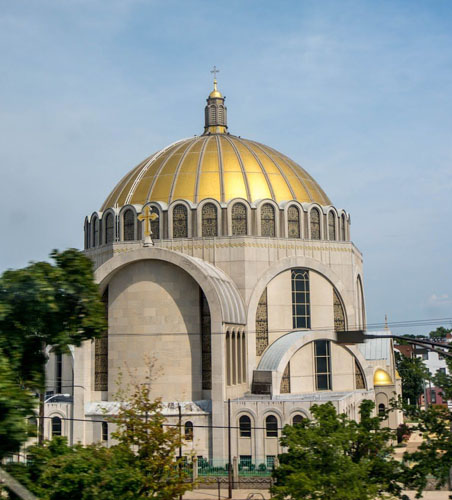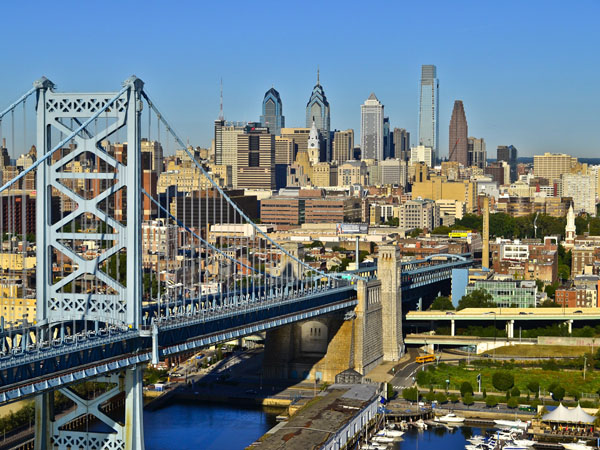Philadelphia
Philadelphia. See Google Map. A city and port (2020 pop 1,603,797) in southeastern Pennsylvania, at the junction of the Delaware and Schuylkill rivers. It has been one of the main centers of Ukrainian settlement: 28,000 of its residents claimed Ukrainian origin in 1980 but other estimates have put this figure as high as 52,740.
Ukrainians from the Lemko region began to settle in Philadelphia in the 1880s. Later arrivals came from Transcarpathia and then from Galicia. They were attracted to the city by jobs in locomotive plants, steelworks, sugar refineries, railway transport, and port facilities. Women worked mostly as domestic help. The earliest organized community structure in the city was a Transcarpathian congregation which established the parish of the Holy Spirit in 1891. Galician immigrants, who were displeased by the Hungarian influence in the parish, soon organized their own Saint Michael’s parish. With the coming of Bishop Soter Ortynsky, the city developed into a religious and educational center. The Cathedral of the Immaculate Conception was opened in 1908. National Prosvita conferences were held in Philadelphia in 1905 and 1909, and a network of reading rooms and Ukrainian schools was set up. The first branch of the Ukrainian National Association was established in 1905, and in 1909 the Society of Ruthenian-American Citizens was founded and housed in its own building. The Basilian order of nuns set up an orphanage in 1911. Saint Paul’s Institute (Minor Seminary) was founded by Bishop Konstantyn Bohachevsky in 1925 (transferred to Stamford, Connecticut, 1933). The Providence Association of Ukrainian Catholics in America established its head office in Philadelphia in 1914, and the Ruthenian Bank was founded in 1915 on Ortynsky’s initiative. When the Greek Catholic exarchate was divided into separate Ukrainian and Byzantine Catholic (Transcarpathian) jurisdictions in 1924, the former established its seat in Philadelphia. In 1958 it was raised to the status of a metropolitanate. Archbishop Ioan Teodorovych moved the seat of the Ukrainian Orthodox Church in the USA from Chicago to Philadelphia in 1925.
During the interwar period Philadelphia’s Ukrainian community developed rapidly. In October 1922 the founding conference of the United Ukrainian Organizations in America was held in Philadelphia, and until 1930 its head office was located there. In July 1936 the League of Ukrainian Catholics staged a Ukrainian-American Olympiad there. By 1936 there were two Ukrainian Catholic churches, one Byzantine Catholic church, one Orthodox church, six community halls, a regular parish school, a girls’ secondary school (both schools run by the Basilian order of nuns), six evening schools of Ukrainian language and culture, four library–reading rooms, three printing presses, and over a dozen women’s, youth, fraternal, sports, and choral organizations. The Catholic triweekly Ameryka (Philadelphia), the Transcarpathian weekly Rusyn, the Orthodox journal Dnipro, the Catholic monthly Misionar (Philadelphia), and the Russophile Pravda all came out in Philadelphia.
The founding of the Ukrainian Congress Committee of America (UCCA) took place in 1940 in Philadelphia, which also is the site of the head office of the United Ukrainian American Relief Committee since its establishment in 1944. In 1948 the World Federation of Ukrainian Women's Organizations was founded in Philadelphia.
During the postwar years almost 6,000 Ukrainian refugees settled in Philadelphia. By 1981 the number of churches had increased to ten Catholic, three Orthodox, two Evangelical-Baptist, and two Pentecostal. A host of new political, social, women’s, veterans’, professional, youth, and sports organizations appeared. The Trident sports club won six championships of the American Soccer League. Three financial institutions prospered: the Ukrainian Savings and Loan Association, the Self-Reliance Federal Credit Union (est 1948), and the Trident Savings Association. Most of the local organizations were affiliated with the local branch of the Ukrainian Congress Committee of America till 1980, when the latter was split into two rival organizations. A number of national organizations had their head offices in Philadelphia, including the Ukrainian National Women's League of America (1943–74), the United Ukrainian War Veterans in America (1949–), the Ukrainian Music Institute of America (1952–9), the Ukrainian Patriarchal Society in the United States (1970–9), and the Saint Sophia Religious Association of Ukrainian Catholics (1977–). The main research and educational institutions in Philadelphia include Manor Junior College (est 1947), the Ukrainian Art Studio (est 1952), the Lypynsky East European Research Institute (est 1963), and a branch of the Ukrainian Catholic University (Rome) (est 1977). The Ukrainian Educational and Cultural Center was established in 1980 to provide physical facilities for a wide range of community activities. It services over 40 organizations, including Saturday school, performing ensembles, professional groups, and youth organizations. In 1982 the Government-in-exile of the Ukrainian National Republic moved its head office to Philadelphia.
The city was home to the Ukrainian Theater in Philadelphia (1949–57) and Teatr u Piatnytsiu (until 1974) under the direction of Volodymyr Blavatsky and Volodymyr Shasharovsky. In 1953 the Kobzar chorus, conducted by Antin Rudnytsky, was founded. In the 1970s it was succeeded by the Prometheus chorus, under M. Dliaboha. A Ukrainian radio program has served the local community since 1939, followed by Blavatsky’s Radio Hour (from 1951), Holos Myrian (from 1971), and the Ukrainian Hour (from 1973).
Publications coming out of Philadelphia in the postwar period include the daily (since 1950) Ameryka (Philadelphia), Misionar (Philadelphia), and literary magazine Kyïv (Philadelphia) (1950–64); the quarterly Ukraïns’ka knyha (Philadelphia) (1971–82); the women’s monthly Nashe zhyttia/Our Life (1944–74); the Catholic weekly Shliakh and its English version The Way (1940–); and the art magazine Notatky z mystetstva/Ukrainian Art Digest (1963–92). Since the early 1900s Philadelphia has been an important Ukrainian publishing center.
Economic prosperity has enabled Ukrainians to move to residential areas in the suburbs. A few old community centers have survived in the inner city, most notably the Catholic community in the Franklin Street vicinity. It encompasses a new cathedral designed by Yulian Yastremsky, several religious institutions, and a senior citizen’s home.
BIBLIOGRAPHY
Shistdesiat' lit orhanizatsiinoho zhyttia ukraïntsiv u Filadel'fiï (Philadelphia 1944)
Zolotyi iuvilei ukraïns’koï hromady v Filiadel'fiï (Philadelphia 1967)
Lushnycky, A. (ed.) Ukrainians in Pennsylvania (Philadelphia 1976)
B. Procko, Myroslav Labunka, Vasyl Markus
[This article originally appeared in the Encyclopedia of Ukraine, vol. 4 (1993).]


